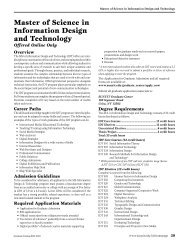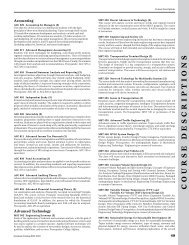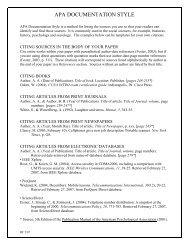Expanding the Public Sphere through Computer ... - ResearchGate
Expanding the Public Sphere through Computer ... - ResearchGate
Expanding the Public Sphere through Computer ... - ResearchGate
You also want an ePaper? Increase the reach of your titles
YUMPU automatically turns print PDFs into web optimized ePapers that Google loves.
CHAPTER 6. ANALYZING THE TALK.ABORTION NEWSGROUP 85<br />
Table 6.2: Categorization of Authors by Number of Messages<br />
Author Type # of<br />
Authors<br />
Cum.<br />
Authors<br />
% of<br />
Authors<br />
Cum.<br />
% of<br />
Authors<br />
% of<br />
Total<br />
Posts<br />
Cum.<br />
% of<br />
Total<br />
Posts<br />
Min.<br />
# of<br />
Posts<br />
Per<br />
Author<br />
Mean<br />
# of<br />
Posts<br />
Per<br />
Author<br />
Very Frequent 15 15 0.5% 0.5% 45% 45% 594 1,392<br />
Frequent 60 75 2.0% 2.5% 25% 70% 81 196<br />
Occassional 75 150 2.5% 5% 9% 79% 34 51<br />
Infreqeunt 149 299 5% 10% 7% 86% 15 22<br />
Very Infrequent 692 991 23% 33% 9% 95% 3 6<br />
Two-time 423 1,115 14% 47% 2% 97% 2 2<br />
One-time 1,575 2,989 53% 100% 3% 100% 1 1<br />
The complete categorization scheme based on frequency is provided in Table 6.2.<br />
Additional descriptive statistics summarizing key measures, are provided in Table<br />
6.3 on <strong>the</strong> following page. This analysis is supplemented by Figures C.1, C.2,<br />
C.3 and C.4 in Appendix C on page 167. All measures are strongly correlated with<br />
<strong>the</strong> number of messages posted, but individually provide additional description of<br />
<strong>the</strong> nature of behavior associated with each author type.<br />
The first measure to be examined is <strong>the</strong> number of threads contributed to. The<br />
number of threads contributed to (hereafter, simply threads) is an indicator of<br />
an author’s breadth of discussion. A larger number of threads may indicate a<br />
wider range of engagement and discussion than a smaller number of threads. As<br />
shown in Table 6.3 on <strong>the</strong> following page, all authors contributed to an average<br />
of 8 threads; however, 75 percent of all authors contributed to only one or two<br />
threads. The median number of threads declines by nearly 85 percent as we move<br />
from very frequent authors to frequent authors, by 70 percent as move move from<br />
frequent to occasional authors, and by 50 percent as we move from occasional to<br />
infrequent authors. Nearly identical patterns are seen as we move down <strong>through</strong><br />
<strong>the</strong> categories along <strong>the</strong> 75th percentile. The high correlation between threads<br />
and number of messages posted (r=.98, see Figure C.2 on page 169 indicates that<br />
posting behavior to threads may be similar for different types of authors. However,<br />
a contrasting pattern emerges when comparing <strong>the</strong> ratio of messages to threads<br />
across different author groups. This ratio is a measure of depth of discussion;
















